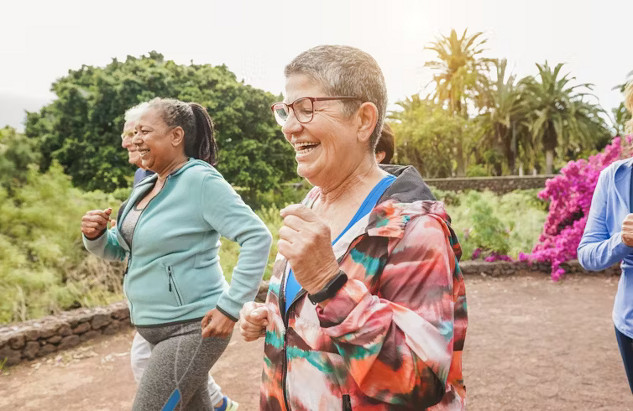
Regular exercise may help lower risk of many common cancers. Tint Media/ Shutterstock
Cancer is the second leading cause of death worldwide. In Europe, almost three in every ten adults were diagnosed with a form of cancer in 2022.
With the recent revelations that three members of the royal family have cancer, many people may be thinking about their own risk of developing cancer – and wondering if there’s anything they can do to prevent the disease.
Cancer is a complex condition, with many factors that may increase a person’s risk. But research shows exercise may actually play an important role – with a growing body of evidence showing its benefit in preventing, treating and living beyond cancer.
Numerous studies have shown a link between regular physical activity and lower risk of being diagnosed with many types of cancer. In some instances, exercise is shown to lower risk of being diagnosed with many common types of cancer – including breast, endometrial, colon and stomach – by around 20%.
A 2015 meta-analysis, which looked at data from over 1.4 million participants, found the most active participants had an over 20% reduction in the risk of seven cancers (including liver, kidney and lung cancer) when compared to those who were the least active. They also had between a 10% and 20% lower risk of colon, bladder, head, neck and breast cancers. This effect remained the same, even after the researchers adjusted for body mass index, which is also associated with greater risk of cancer. This shows that the more active you are, the lower your overall risk of cancer.
There are several possible mechanisms by which exercise is thought to reduce cancer risk. Regular exercise deeply affects many aspects of the body’s metabolism. For instance, it influences the behaviour and concentration of certain hormones – such as insulin and oestrogen, which have been linked with colon, breast, pancreatic, prostate and endometrial cancers.
Exercise also improves cellular function, encouraging cell repair – and, when not possible, destruction. This is important, as cancer starts when these damaged cells cannot be destroyed or repaired. It also reduces chronic inflammation, which is linked with risk of all cancers, as well as other chronic diseases – including cardiovascular disease and diabetes.
Exercise also helps prevent and reduce obesity. This on its own lowers the risk of developing at least 13 types of cancer, including breast, colorectal and pancreatic cancer.
Of course, cancer is caused by many factors so there is no one simple defence against it. But based on the evidence we have, there’s clear benefit in being more active.
From diagnosis to survival
Exercise is also shown to be beneficial during and after cancer treatment. For example, research in patients diagnosed with lung cancer found doing exercise before surgery actually had lasting benefits during recovery.
Researchers gathered patients diagnosed with lung cancer, who were due to undergo surgery to have part of their lung removed. As you can imagine, this surgery has a serious affect on a person’s life. During the recovery period, patients may struggle with normal, everyday tasks – such as washing up and walking around.
Patients were divided into two groups. One group performed different types of exercise (aerobic, resistance and breathing exercises) three to five times a week. The other group (the control group) performed no exercise. After four weeks, the exercise group was obviously fitter. But most important was that three months after surgery, the exercise group had remained fitter and stronger compared to the control group. This meant they were better able to perform their usual daily activities.
This research suggests that exercise prepared them better for surgery, which subsequently meant a shorter journey to full recovery.
Exercise can also help manage some of the side-effects of cancer treatment – particularly the debilitating fatigue around 90% of patients experience. Though it might sound counter-intuitive, evidence tells us that the more active you are throughout treatment, the less fatigue you’ll experience.
One study which looked at the effect of exercise on 80 breast cancer survivors found that participants who exercised three times a week for two months had significantly lower levels of fatigue. This effect persisted even six months after they stopped training.
A meta-analysis of 113 studies also showed that exercise was more effective in reducing treatmented-related fatigue than pharmaceuticals were.
Research on breast cancer patients even suggests exercise could improve chemotherapy completion rates. This could improve treatment outcomes and lead to higher survival rates. However, not all studies in this area have had these results. As such, it will be important for more research to be done to better understand the relationship between exercise and chemo completion rates.
Regular physical activity could also reduce cancer recurrence by as much as 30%, especially for bowel and breast cancer.
The mechanisms that are thought to help reduce cancer risk are very similar to those that help during recovery – including improved immunity, better circulation, reprogramming the metabolism and improving body composition by retaining muscle and diminishing fat.
How active should you be?
Of course, not everything has been figured out yet. The majority of evidence comes from observational studies which means we can only show a link between exercise and the benefits it has. We desperately need more patients to participate in randomised clinical trials so we can definitively establish what the beneficial effects are. This is something my colleagues and I are currently researching at the University of Hull.
Still, it’s clear that exercise is extremely beneficial for preventing cancer – and that it’s safe and helpful for people during and after cancer treatment.
To get these benefits, it’s recommended for people exercise for at least 75-150 minutes of moderate and vigorous activities per week. Doing 30 minutes of exercise five days a week is ideal.
Do a mix of aerobic exercises (such as swimming walking or cycling) and around two to three sessions of resistance training (such as weight lifting or pilates). These guidelines are similar for people living with or beyond cancer.
However, even if you can’t exercise this much, don’t be disheartened. A little physical activity is better than nothing.![]()
Sebastian Mora Hernandez, Research Associate in Exercise Oncology & Cancer Rehabilitation Specialist, University of Hull
This article is republished from The Conversation under a Creative Commons license. Read the original article.
Related Books:
The Body Keeps the Score: Brain Mind and Body in the Healing of Trauma
by Bessel van der Kolk
This book explores the connections between trauma and physical and mental health, offering insights and strategies for healing and recovery.
Click for more info or to order
Breath: The New Science of a Lost Art
by James Nestor
This book explores the science and practice of breathing, offering insights and techniques for improving physical and mental health.
Click for more info or to order
The Plant Paradox: The Hidden Dangers in "Healthy" Foods That Cause Disease and Weight Gain
by Steven R. Gundry
This book explores the links between diet, health, and disease, offering insights and strategies for improving overall health and wellness.
Click for more info or to order
The Immunity Code: The New Paradigm for Real Health and Radical Anti-Aging
by Joel Greene
This book offers a new perspective on health and immunity, drawing on principles of epigenetics and offering insights and strategies for optimizing health and aging.
Click for more info or to order
The Complete Guide to Fasting: Heal Your Body Through Intermittent, Alternate-Day, and Extended Fasting
by Dr. Jason Fung and Jimmy Moore
This book explores the science and practice of fasting offering insights and strategies for improving overall health and wellness.
Click for more info or to order























